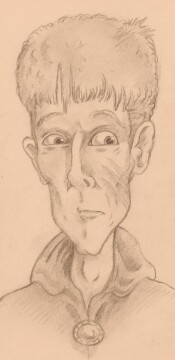Mort
This article is about the character. For the book of the same name see Mort.
Sto Helit Family Motto: NON TIMETUS MESSOR
Fear Not The Reaper
His Grace, The Duke of Sto Helit, Lord Mortimer Sto Helit.
| Lord Mortimer, the Duke of Sto Helit | |
 | |
| Name | Mortimer "Mort" |
| Race | Human (Briefly became an Anthropomorphic personification) |
| Age | |
| Occupation | Duke of Sto Helit, formerly apprenticed to Death |
| Physical appearance | Tall, red haired and possessing more than the usual allotment of knees. |
| Residence | |
| Death | Beginning of Soul Music, Dead Man's Curve |
| Parents | Lezek (father) Death (father-in-Law) |
| Relatives | Hamesh (Uncle) |
| Children | Susan (daughter) |
| Marital Status | Married to Ysabell |
| Appearances | |
| Books | Mort |
| Cameos | |
Mort (short for Mortimer) is a young boy from the Ramtops, son of Lezek. He was very thin during his childhood, and he lived at his father's farm until he was old enough to go to apprenticeship, becoming Death's apprentice at the stroke of midnight. There he learned about the fabrics of time and space, the thin line between life and death, and how to clean out Binky's stable. During the course of his apprenticeship, Mort acquired some of Death's special abilities, such as the ability to see the dead and to walk through walls.
As the book progresses, Mort develops more and more Death-like traits: he learns to speak with the voice and Ysabell is alarmed to notice his brown eyes have turned to Death's icy blue. Correspondingly, Death himself becomes more human, as if the roles are shifting, and for the first and only time, His voice is rendered in lowercase, and with quotation marks.
However, the first time Mort does the job by himself, he saves someone instead of collecting their soul, causing a rift in time and space, between what actually happened and what was supposed to happen. In attempting to maintain the reality that he created, Mort rebelled against his Master, resulting in a swordfight in Death's own home.
Mort lost, but Death changed his mind about killing him, perhaps due to what Mort said, or perhaps Death saw Susan witnessing the fight, and realised that it was necessary to keep his apprentice alive. It should be mentioned that during Mort's apprenticeship, his father never knew what Mort was doing; he thought Mort was an apprentice to an undertaker, because of his own subconscious unwillingness to see Death.
Mort married Ysabell and became the Duke of Sto Helit. The couple subsequently traveled extensively among the Sto Plains cities, conducting diplomatic visits to discourage wars that the previous Duke - a chance casualty of Mort - had originally been destined to suppress by force. Both were killed in a coach accident in Soul Music, even though Death had offered them an immortality of sorts in his own realm. Their daughter, Susan Sto Helit, inherited the slap-mark-like birthmark that Death had left on Mort's face.
Annotations
- The motto of the Sto Helit family is; Non Timetus Messor, which is translated in the article concerning links with the Roundworld heavy rock band Blue Öyster Cult, whose biggest hit record on Roundworld was....
- After the appointment of Mort as the new Duke of Sto Helit, the Sto Helit family coats of arms is, mysteriously, (due to their ties with Death,) a shield with pair of scythes crossed against it, and a hourglass where the scythes cross.
On Roundworld,such a shield was the emblem of a unique New York dining club, who set about methodically ridiculing the susperstition that the number thirteen and the day Friday were inherently unlucky, by deliberately dining thirteen to a table on every Friday the Thirteenth. Active between 1881 and the First World War, the Thirteen Club [1] and its members suffered no greater ill-fortune than would be attributable to chance, and the club emblem on its menus and letterheads was indeed two scythes crossed in front of an hourglass with the motto Morituri Te Salutamus (We who are about to die salute you").

- During the events in In The Light Fantastic, Rincewind overhears Twoflower teaching the Four Horsemen of the Apocalypse, (Death, Famine, Pestilence and War,) how to play bridge. At one point, War refers to Death as "Mort" but the reader later learns that the only people in the room, (other than Twoflower,) were Death, Famine, Pestilence and War. The name might be a possible reason as to why Death chose Mort as his apprentice. When Death first meets Mort and learns Mort's name ('Mort' being the Quirmian word for 'death'), he comments, What a coincidence.